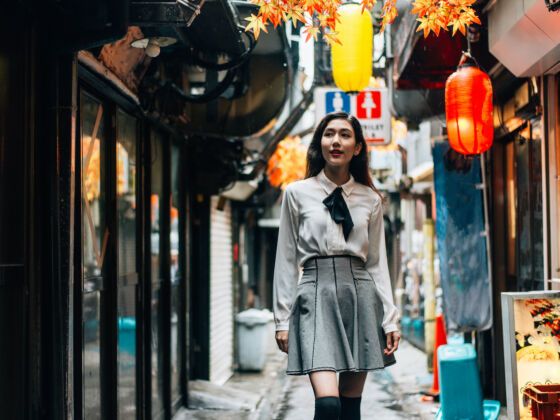To be exotic is to be desirable. Those who travel, I think, understand that better than most people. When we plan our travels, we never yearn for a place familiar or known. We want somewhere alien, mysterious, and foreign. We want new. There’s a reason travelers flock to locations with black-sand beaches and volcanoes on the horizon, with foods we’d never find at home, or with languages that make us trip over our own tongues. We gorge ourselves on the unusual. When faced with an exotic experience, we can’t help but be reminded of just how far away we are from home. (And for travelers, that’s a good thing.)

The more I’ve traveled, though, the more I’ve realized that exoticism has a fascinating duality.
On one hand, everything is exotic. To one person, exoticism means ceviche in Peru, Holi in India, and olive skin. To another, it’s falafel in Turkey, Loi Krathong in Thailand, and cornsilk blonde hair. To yet another, the exotic is personified by macarons in Paris, Carnival in Venice, and almond-shaped eyes. For every person, the unfamiliar wears a different face. Technically that means that every crack, crumb, and crevice of the world is exotic.
And yet at the same time, nothing is exotic. Anything considered exotic by one person is completely average to another. To a certain person, the most unusual, exciting, bizarre thing isn’t alien. That beach with powdered-sugar sand fringed by crystalline waters of the purest blue that you’ve pegged as your next dream destination? For someone, it’s just the backyard. Those brilliant, jewel-toned sarongs you’re desperate to barter for in an open-air bazaar? For someone, they’re everyday wear. That perfect, glistening sushi cut that has your mouth watering? For someone, it’s Tuesday dinner. Whatever you yearn for, be it food, an experience, or a location, it’s almost guaranteed to be viewed as a commonplace part of life by someone.
Travel teaches us that the exotic, just like beauty, is in the eye of the beholder. What is exotic for one is average for another. What is commonplace for one is mystifying for another. And we can’t learn that without experiencing the disparity for ourselves.
I face that juxtaposition on a near daily basis. In America, I don’t stand out. In a country that has prided itself on being a “melting pot,” the vast spectrum of skin tones, hair and eye colors, heights, and weights means I’m just another blue-eyed, dirty-blonde-haired, slightly tall, average-framed, pale-skinned woman. There are thousands more like me. It’s an interesting oxymoron: Because everyone is so different, your differences largely go unnoticed. I am the opposite of exotic. I am vanilla.
That changed when I moved to Japan, where 99% of the population is homogenous. (To be clear, I am not claiming all Japanese people look alike. I’m only saying when it comes to hair, eye, and skin color, the spectrum is much less varied.) Here, especially in the rural regions, I’m suddenly the one who sticks out.
That is never clearer to me than at the beginning of the school year in April, when there are suddenly 300 new students roaming the halls of the school where I teach English. Most of them are too shy to speak to me during the first few weeks, but for the brave ones, the first words out of their mouths are almost always “青目” (ao me, “blue eyes”), voiced in a tone that’s usually equal parts surprise, awe, and envy. If I got 100 yen for every time I’ve heard that phrase recently, rent this month would easily be paid. My eyes, true, are a vivid enough blue that they get remarked on in America, but in Japan? They make me an anomaly to be gawked at.
That reaction is strengthened even further when I stand up. At 5’9”, I tower over the vast majority of the population. One of my more poetic students remarked one day, while I was practicing Japanese archery with my long hair down, that I looked like an Amazon warrior. In Japan, land of kimono, sushi, and kendo, I am the exotic one.
It’s funny to see how our perception of what is exotic changes depending on the place. The more foreign and novel something is, the more exotic. When I moved to Japan, I considered everything peculiar, from the kawaii charms that adorned my students’ cell phones to the fact that I got seaweed in my daily bentou box from the cafeteria. Now, almost two years later, the alien has become run-of-the-mill.
When you travel, you see this skewed view of exoticism in other ways, too. McDonald’s in Japan often has “Texas” or “Idaho” burgers (and the advertisements usually feature some sort of cowboy, because, you know…that’s America), and they’re usually wildly popular. “Exotic” might not be the word that comes to mind when describing a hamburger, but they’re still viewed as something out of the ordinary. In actuality, there’s really nothing remarkable about them, but the very fact that they’re associated with a far-off place makes them seem special and unique.
Stepping outside of our comfort zones means we can realize the thing we admired and dreamed about is considered normal by everyone else. Or, alternatively, we find out our “normal” is someone else’s “bizarre.” Whatever the case, it makes you appreciate what you have. You learn to look at things — whether they are new or completely familiar — through the eyes of another.